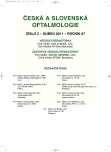Benzalkonium Chloride Daily Dose – an Important Criterion in Glaucoma Treatment
Authors:
P. Výborný; S. Sičáková
Authors‘ workplace:
Oční klinika 1. LF UK a ÚVN, Praha, přednosta doc. MUDr. Jiří Pašta, CSc.
Published in:
Čes. a slov. Oftal., 67, 2011, No. 2, p. 63-66
Category:
Original Article
Overview
Preservatives in eye drops, especially benzalkonium chloride (BAC), may act as cytotoxic; furthermore, it may cause the instability of the tear film, conjunctivitis, subconjunctival fibrosis, epithelium apoptosis and worsening the prognosis of possible surgical treatment. The patient’s subjective symptoms may decrease his compliance. For better orientation in this issue, the authors calculated the daily BAC doses in eye drops used in the glaucoma treatment. Significant differences are caused by different size of the drop in specific medicament, different BAC concentrations in the volume unit of the package, and frequency of application. The daily BAC doses are in micrograms as follows: Beta-blockers: Timo-COMOD 0.0, Arutimol 2.6, Vistagan 2.8, Timolol POS 3.0, Arteoptic 3.7, Carteol 4.0, Betoptic S .8, Timoptol MSD 6.3, Betoptic 10.0. Alpha-mimetics: Alphagan and Luxfen 3.5, Aruclonine 7.1. Prostaglandin derivates, prostamides and docosanoides: Taflotan 0.0, Lumigan 1.4, Unilat 3.0, Travatan 3.9, Rescula 5.8, Xalatan 6.0, Latanoprost-ratiopharm, Xaloptic, Latanoprost Actavis, Latanoprost Arrow, Solusan, Glaucotens 6.0. Carbonic anhydrase inhibitors: Azopt 4.8, Trusopt 5.4. Fixed combinations: Ganfort 1.4, Combigan 3.2, Duotrav 4.3, Cosopt 5.6, Xalacom 6.0.
Key words:
Benzalkonium chloride, glaucoma, compliance
Sources
1. Ayaki M, Iwasawa A: Cytotoxicity of prostaglandin analog eye drops preserved with benzalkonium chloride in multiple corneoconjunctival cell line. Clinical Ophthalmology, 2010, 4: 919–924.
2. Ayaki M., Iwasawa A., Inoue Y: Toxicity of antiglaucoma drugs with and without BAK to cultured human corneal endothelial cells. Clinical Ophthalmology 2010, 4: 1217–1222.
3. Baudoin C., Liang H., Hazard P. et al.: The ocular surface of glaucoma patients treated over the long term expresses inflammatory markers related to both T‑helper 1 and T-helper 2 pathways. Ophthalmology, 115, 2008: 109–115.
4. Baudoin, Ch., Labbe A., Homg L. et al: Preservatives in eye drops: the good, the bad and the ugly. Progress in Retina and Eye Research (17 March 2010) doi:10.1016/j.preteyres.2010.03.001 Key: citeulike: 6879370.
5. Brasnu E., Brignole-Baudoin F., Riancho L. et al.: In vitro effects of preservative-free tafluprost and preserved latanoprost, travoprost, bimatoprost in conjunctival epithelial cell line. Curr Eye Res, 33, 2008: 303–312.
6. Broadway D.C., Grierson I., O’Brien C., et al: Adverse effects of topical antiglaucoma medication. Arch Ophthalmol, 112,1994,11: 1437–1445.
7. Debbasch C., Pisella P.J., De Saint Jean J.M., et al.: Mitochondrial activity and glutathione injury in apoptosis induced by unpreserved and preserved beta-blockers on Chang conjunctival cells. Invest Ophthalmol Vis Sci, 42, 2001: 2525–2533.
8. De Saint Jean M., Brignole F., Briguier A.F. et al.: Effects of benzalkonium chloride on growth and survival of Chang conjunctival cells. Invest Ophthalmol Vis Sci, 40, 1999: 619–630.
9. Guenoun JM, Baudoin C., Rap P., et al.: In vitro comparison of cytoprotective and antioxidative effect of latanoprost, travoprost, and bimatoprost on conjunctiva-derived epithelial cells. Invest. Ophthalmol Vis Sci, 46, 2005: 4594–4599.
10. Guenoun JM, Baudoin, C., Rap, P. et al.: In vitro study of inflammatory potential and toxicity profile of latanoprost, travoprost and bimatoprost in conjunctiva-derived epithelial cells. Invest Ophthalmol Vis Sci 46,2005: 2444–2450.
11. Hamard P., Debbasch C., Brignole F., et al.: Toxicity of preserved and unpreserved antiglaucoma eye drops on human cultured trabecular cells. Invest Ophthalmol Vis Sci, 43, 2002: E-Abstract 1035.
12. Hirano S., Sagara T., Sizuki K., et al.: Inhibitory effects of antiglaucoma drugs on corneal epithelium migration in rabbit organ culture system. J Glaucoma, 13, 2004,3: 196–199.
13. Krieglstein G.K.: Is compliance a barrier? European Glaucoma Society Meeting, Madrid 2010, Abstracts MS7.1.
14. Leung, E.W., Medeiros F., Weinreb R.N: Prevalence of ocular surface disease in glaucoma patients. J Glaucoma, 17, 2008, 5: 350–355.
15. Levrat F., Pisella PJ, Baudoin C.: Clinical tolerance of antiglaucomas eyedrops with and without a preservative. Results of an unpublished survey in Europe. J Fr Ophtalmol, 22, 1999, 2: 186–91.
16. Liang H., Baudoin G., Pauly A. et al.: Conjunctival and corneal reactions in rabbits following short-and repeated exposure to preservative-free tafluprost, commercially available latanoprost and 0,02% benzalkonium chloride. Br J Ophthalmol, 92, 2008: 1275–1282.
17. Takahashi N.: Quantitative cytotoxicity of preservatives evaluated in cell culture with Changęs human conjunctival cells – effect of temperature on cytotoxicity. Jpn J Ophthalmol, 26, 1982: 234–238.
18. Van Bijsterveld O.P., Lemp M.A., Spinelli D.R.M., et al.: The effect of different benzalkonium chloride in concentrations on human normal ocular surface: a controlled prospective impression cytology study. In: van Bijsterveld O.P., Lemp M.A., Spinelli D. (Eds) The lacrimal system. Amsterdam, Kugler, 1991, 89–91.
19. Výborný, P., Sejčková L.: Antiglaukomatika – obsah konzervačních látek a spolupráce pacienta v léčebném režimu. Čes Slov Oftal, 62, 2006, 5: 270–274.
Labels
OphthalmologyArticle was published in
Czech and Slovak Ophthalmology

2011 Issue 2
Most read in this issue
- Benzalkonium Chloride Daily Dose – an Important Criterion in Glaucoma Treatment
- Ocular Signs and Symptoms after Scoliosis Surgery (a Case Report)
- Visual Functions and Quality of Life in Patients with Keratoconus
- Keratoconjunktivitis sicca (KCS) při folikulární konjunktivitidě u dospělých pacientů s etiologií Chlamydia pneumoniae (souhrnná dvanáctiletá studie)
